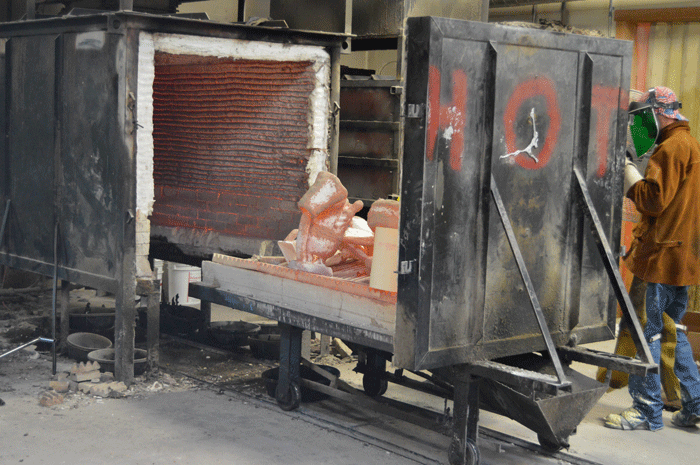Once the shells are completely dry they are moved onto the pour floor. The shell that has formed on top of the wax circles (remember back to spruing?) and top of the sprue bars are cut off with a saw to expose the wax inside. They are now inverted in the de-wax oven (autoclave) and are heated to approximately 900 degrees. The wax now melts and pours through the metal screen that the shells sit on and into the waiting container below. This way most of the wax can be reclaimed; when it cools it will be put back into use elsewhere in the foundry.
The furnace that Madd uses is an electric induction furnace, much faster and more efficient than the cheaper gas powered models. It sucks so much electricity that it can only be operated during "non-peak" hours or the energy usage alone would make casting cost prohibitive.
 |
| The bronze ingots are heated to 2,100 degrees then decanted into a crucible. |
 |
| And. Here. We. Go. |
 |
| In goes the bronze, out come the gasses. When the shell is topped off, they move on to the next one. |
 |
| The crucible is suspended by a steel bar so that both men can better control the bronze flow. |
 |
| Held vertically in place by the sand, the shells will need to cool down now that the bronze is cast. |
 |
| Note the bronze glowing as it cools down. |
 |
| So far so good! Incredible job, guys!! |
I must admit that I knew in my heart that everything was going to turn out great; there was no way that I could have gone through so much to get to this point to only have disaster strike. Still, the mind is a bag of snakes and I was pacing nervously like an expectant father.
Next up: we begin the knock-off and sandblasting to reveal the bronze Waterbearer. Stay tuned!

No comments:
Post a Comment